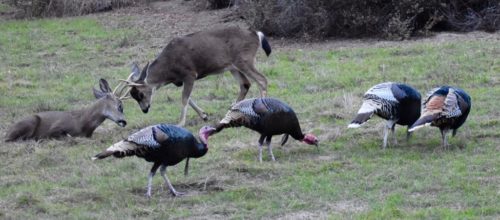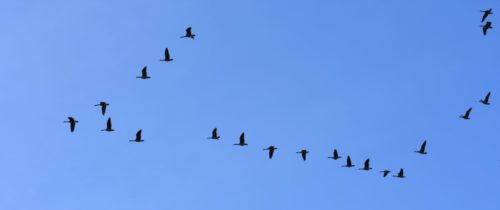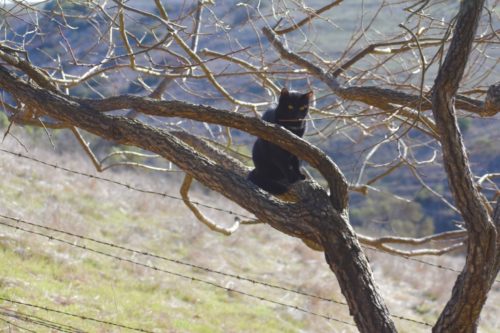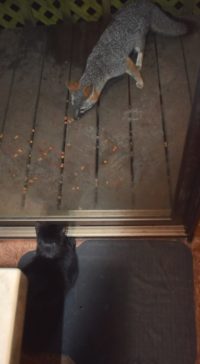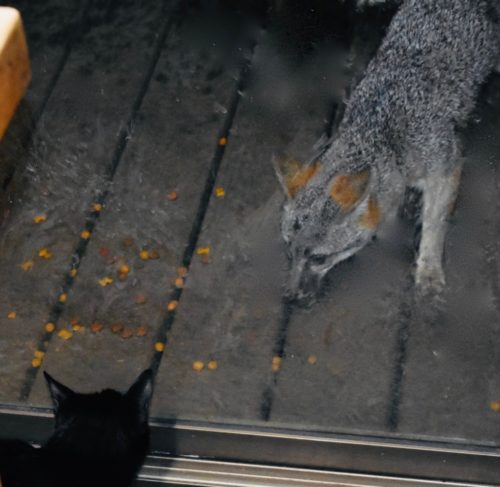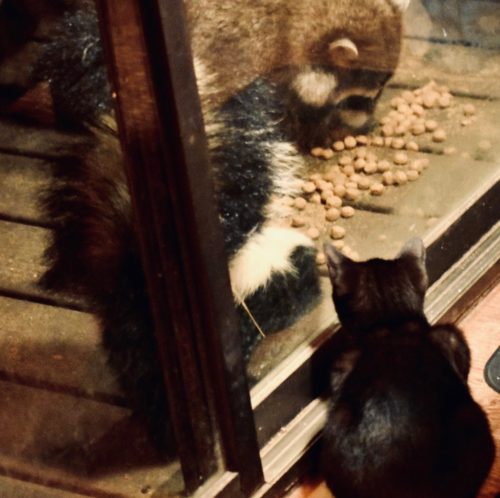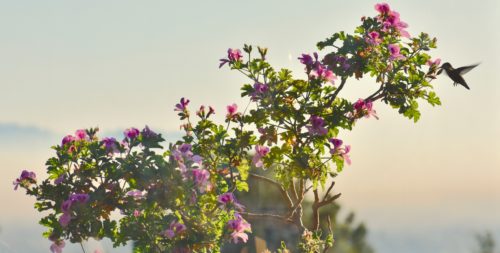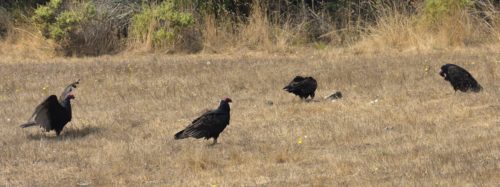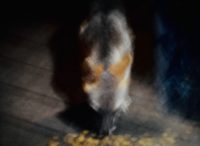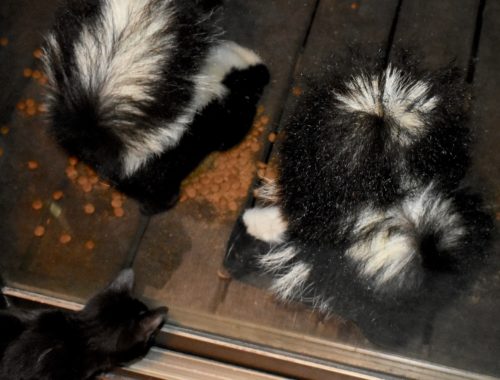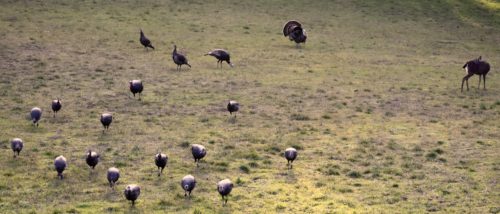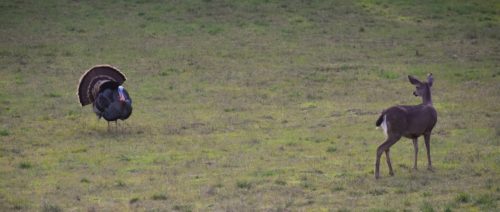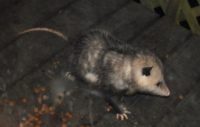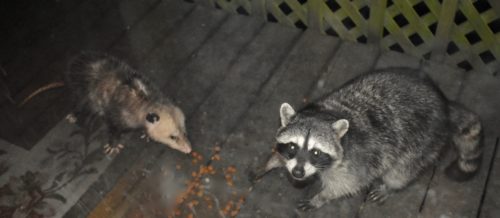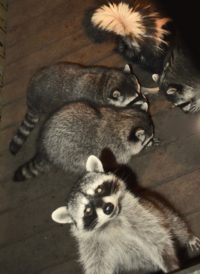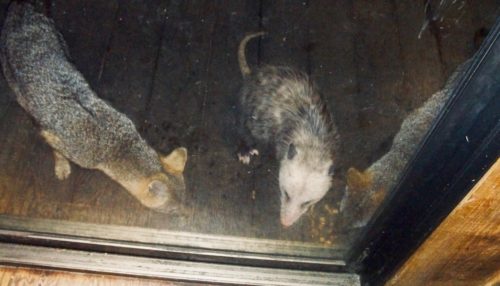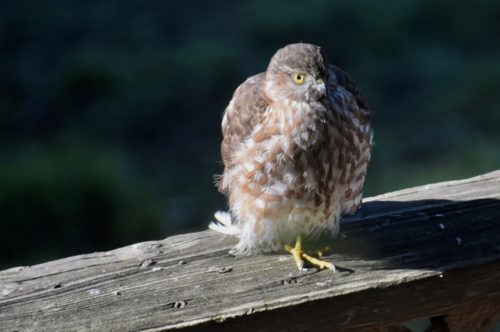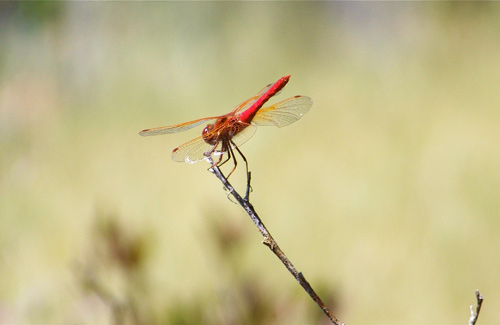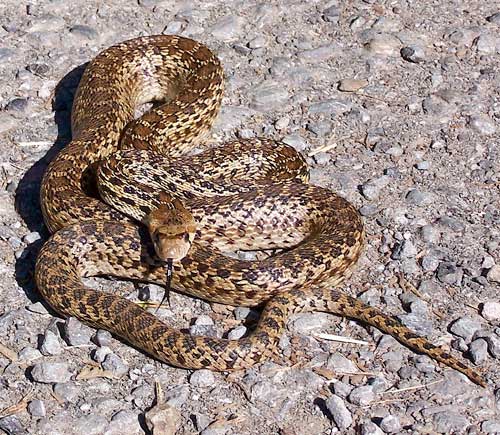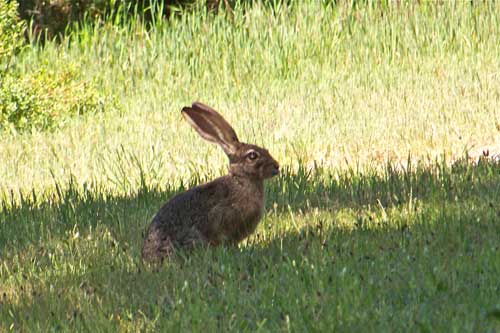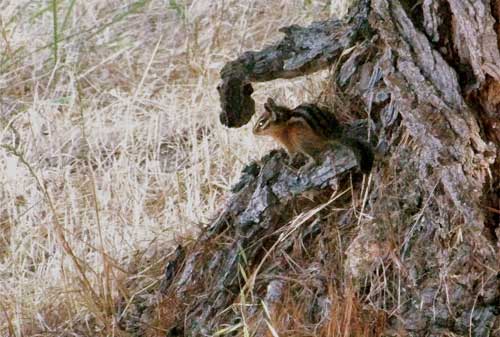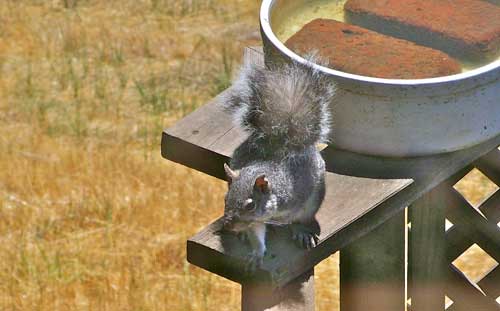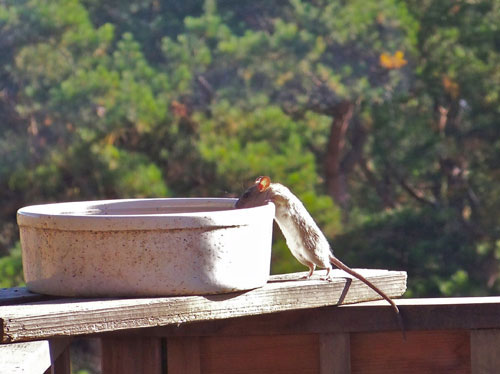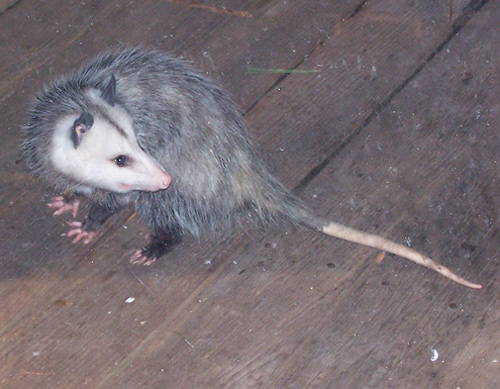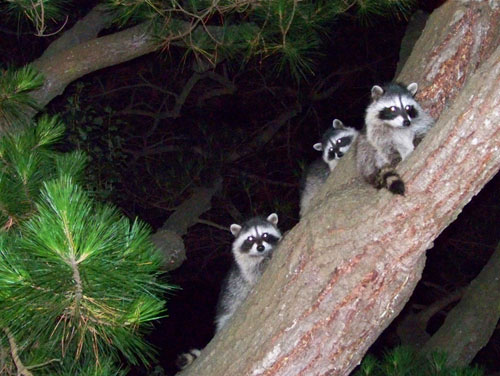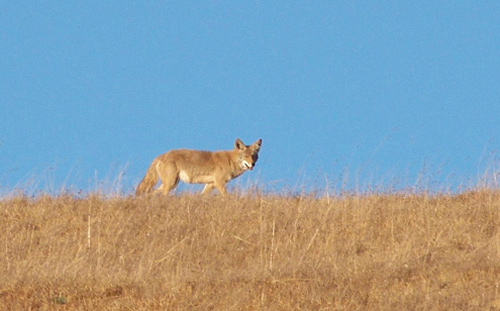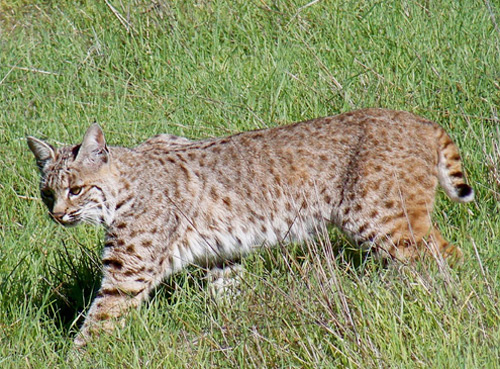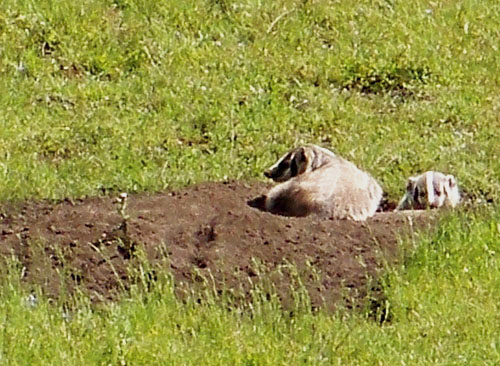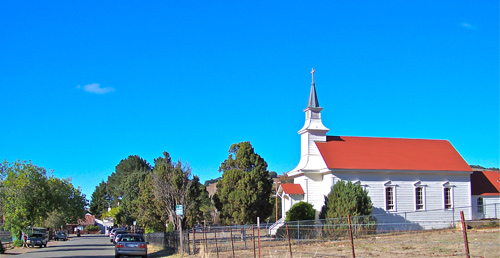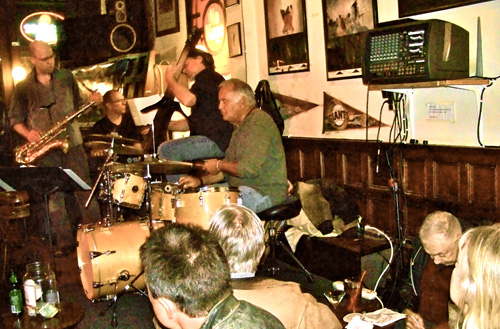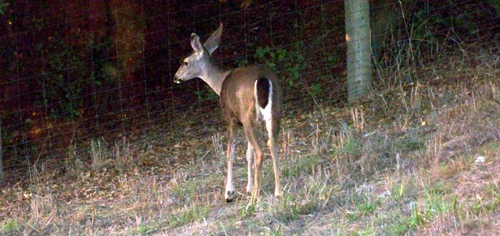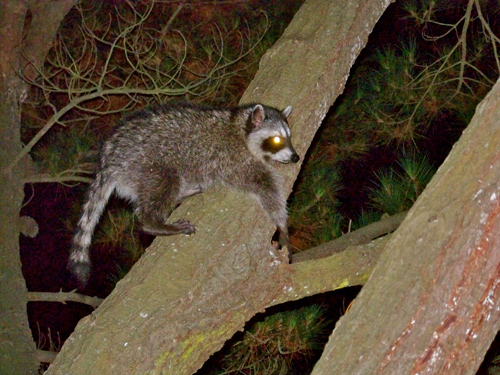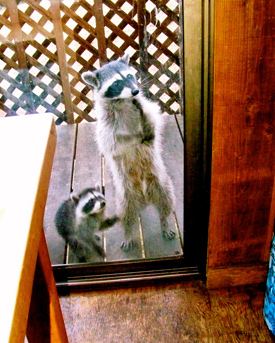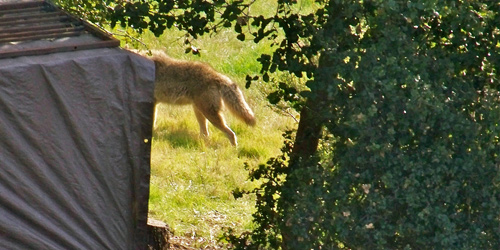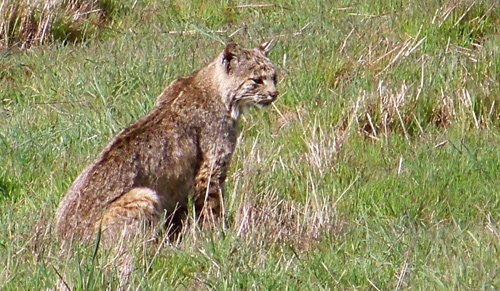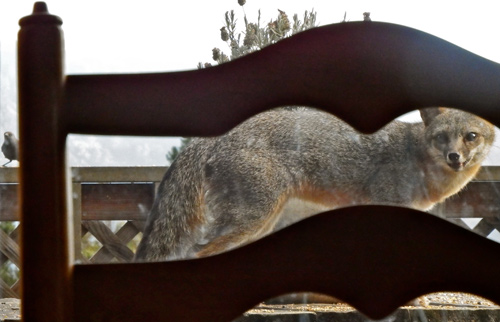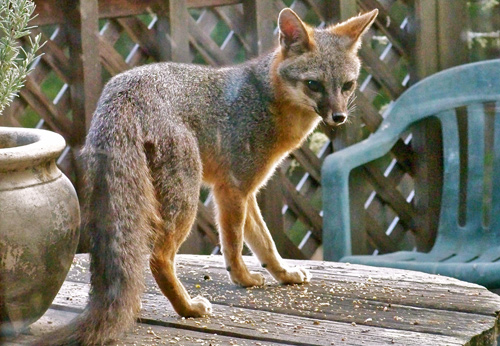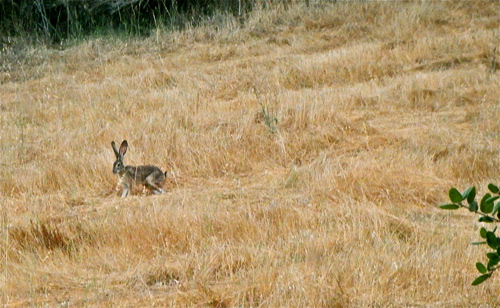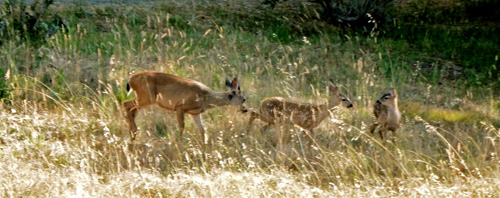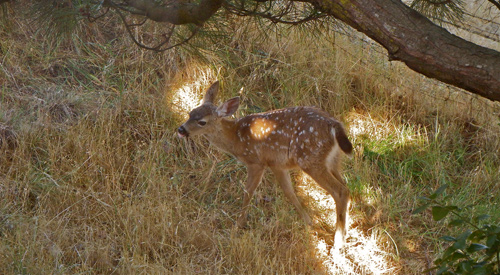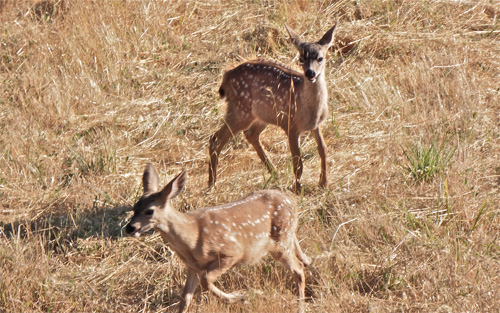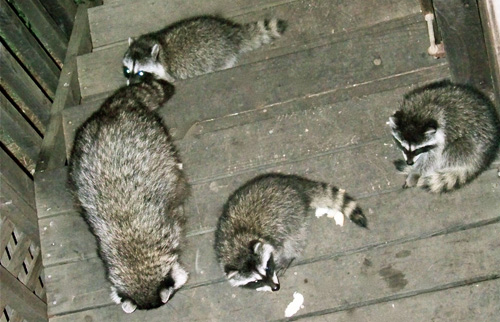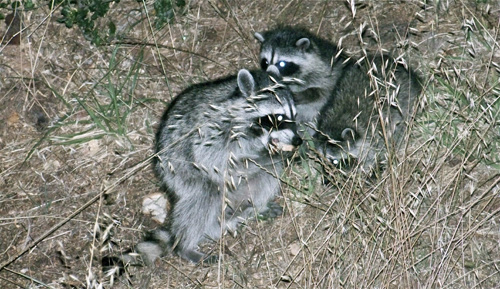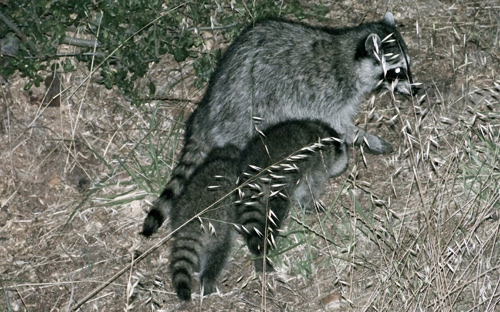Entries tagged with “gray fox”.
Did you find what you wanted?
Sat 19 Dec 2020
Posted by DavidMitchell under Uncategorized
Comments Off on Species intermingling
Located on a grassy hillside, Mitchell cabin is constantly in the midst of various wildlife: at least 40 species and subspecies of birds, along with various snakes, lizards, salamanders, frogs, deer, skunks, coyotes, raccoons, foxes, gophers, roof rats, field mice, squirrels, cottontails, jack rabbits (which are actually hares), bobcats, and the occasional badger.
I’m always impressed by how often the different species manage to get along with each other.
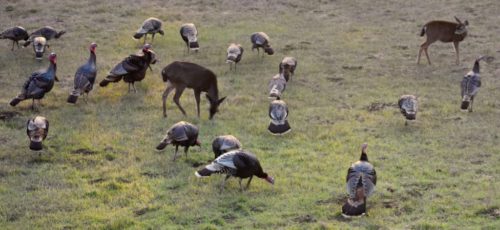
A flock of wild turkeys casually wander past a couple of grazing deer.

The turkeys, in fact, are so indifferent to the deer that when a young buck challenges a weary companion, they don’t even notice.

And even when the two bucks start actually sparring, the turkeys just continue their hunting and pecking.

A flock of Canada geese fly overhead honking as they go.

Add a domestic cat to this mix and the wildlife come to resemble zoo animals. Here Newy, the stray cat we adopted last summer, climbs a persimmon tree to take it all in. Last week’s posting showed her in the grass interacting with deer and wild turkeys.

Many of Newy’s wildlife displays, however, present themselves at our kitchen door. Here she studies a gray fox eating dog kibble left behind by raccoons.

The fox soon spots Newy but just gives her a quick glance.

Newy was traveling with several raccoons when she first showed up in late July. A veterinarian, who later spayed her and trimmed her claws, estimated her age as five to six months. While she enjoys keeping an eye on her raccoon friends, the unfamiliar skunks particularly fascinate her. Like the fox, a couple of skunks regularly show up to enjoy the last of the raccoons’ dinner. For her, the scene is all part of the zoo in which she finds herself now living
Mon 21 Sep 2020
Posted by DavidMitchell under Point Reyes National Seashore, West Marin nature, Wildlife
Comments Off on Home sometimes seems like an animal shelter
Caveat lectorem: When readers submit comments, they are asked if they want to receive an email alert with a link to new postings on this blog. A number of people have said they do. Thank you. The link is created the moment a posting goes online. Readers who find their way here through that link can see an updated version by simply clicking on the headline above the posting. All other readers already have an updated version.
Sheltering in place with only limited socializing definitely affects one’s thinking. It forces many of us to spend more time alone taking stock of ourselves and of our lives. It’s a humbling experience and may provide an inkling of why a prisoner behind bars cannot avoid thinking about his life. But, as I’m sure the prisoner knows, too much such thinking becomes tedious. For the moment, I’m trying to divert my attention to the creatures I find all around me.

A hummingbird a week ago enjoyed a few sips before the smoke from the Woodward Fire significantly dissipated. As of this writing, the fire, which a lightning strike started on Aug. 18, was 97 percent contained, having blackened 4,929 acres in the Point Reyes National Seashore.

A coyote wandered up to the greenhouse of neighbors Dan and Mary Huntsman on August 21. Had I been looking out my living-room window, this is what I would have seen. Alas, I wasn’t looking, but Dan was and from his home took this picture. (Photo by Dan Huntsman)

Buzzards on Sept. 13 feast on the carcass of a skunk presumably killed by a great horned owl. It was the second time in recent weeks buzzards dined on a skunk near Mitchell cabin.

A gray fox showed up on our deck after dark last week to dine on the last bits of kibble I had given some raccoons earlier.

A skunk goes eye to eye with Newy, the stray cat we adopted in late July. More frequently than the fox, skunks show up after the raccoons to pick through what remains of the kibble.
And in a weather vein: Whenever Lynn opened the bedroom window in recent days, I started sneezing and then coughing. “Do you think it’s pollen or smoke that’s causing the sneezing?” she asked me a couple of days ago. “The answer,” I told her, “is blowing in the wind.”
I’ll stop here. There’s a lot I’m tempted to write about our political situation, but I think I’ll save that for another week.
Wed 19 Feb 2020
Posted by DavidMitchell under Photography, West Marin nature, Wildlife
Comments Off on Some of the critters that have been visiting here of late
Caveat lectorem: When readers submit comments, they are asked if they want to receive an email alert with a link to new postings on this blog. A number of people have said they do. Thank you. The link is created the moment a posting goes online. Readers who find their way here through that link can see an updated version by simply clicking on the headline above the posting.
Needing a break from the political scene, I spent much of the past week photographing the critters that show up at Mitchell cabin.

Eleven blacktail deer grazing near Mitchell cabin last Saturday.

Following the deer up the hill were 21 wild turkeys.

Which led to an unusual stare-down.

For almost three years there’d been a dearth of possums around Mitchell cabin, but this past week two showed up on our deck after dark to nibble kibble.

Here a possum and raccoon dined together with no confrontations Sunday evening.

Raccoons, of course, are fairly comfortable around a number of other animals. Here four of them ate kibble alongside a skunk last fall.

And here a possum dined contentedly between two gray foxes just outside our kitchen door awhile back.

But the most integrated dining I have seen were this possum, fox, and raccoon, which I photographed together next to the kitchen door in 2011.

Monday morning Lynn woke me up so I could see this sharp-shinned hawk on the railing of our lower deck. The young hawk’s expression is mighty stern, and I fear it may be hunting the birds that show up on our upper deck to eat birdseed. (Photo by Lynn Axelrod Mitchell)
In short, not all wildlife live in harmony around here.
Mon 5 Jan 2015
Posted by DavidMitchell under West Marin nature, Wildlife
Comments Off on A gallery of the critters around Mitchell cabin
 Around the first of the year I sometimes post a roundup of the creatures that have shown up around Mitchell cabin.
Around the first of the year I sometimes post a roundup of the creatures that have shown up around Mitchell cabin.
This year I’m doing it again, starting with a butterfly and dragonfly followed by a variety of larger critters.
This exhibit ends with a coyote, a bobcat, two badgers, and two deer rubbing noses.
Regular readers of this blog will recognize some of these photos from past postings.
Here a buckeye butterfly rests on a chrysanthemum that’s growing in a flowerpot on the deck. ___________________________________________________________________

A dragonfly pauses on the twig of a tree that’s next to the deck. Dragonflies can easily be distinguished from damselflies because when they are at rest they leave their wings extended while damselflies close their wings over their bodies when at rest. __________________________________________________________________
 A Pacific tree frog on a bamboo shoot near our hot tub.
A Pacific tree frog on a bamboo shoot near our hot tub.
Some people call them Pacific chorus frogs. During the winter, their main mating season, males make their way to water and then charm females to the water with a chorus of chirping.
________________________________________________________________

Gopher snakes are not poisonous, but they mimic rattlesnakes, coiling up and wagging their tongues when threatened. This one was near the foot of our driveway.

A jackrabbit in the field outside our kitchen window pauses to look around .

This is the only chipmunk I’ve ever seen around Mitchell cabin. I’m just glad I had my camera nearby when it showed up.

A Western gray squirrel basks in the sun after taking a drink from our birdbath.

A roof rat takes a drink from the birdbath. These rats originated in southern Asia, and you’ll recall it was their fleas that spread the Black Death throughout Europe in the 14th Century, killing roughly half the people.

This cute possum used to be a regular nighttime visitor, but so many raccoons have been hanging around the cabin in the evening that we seldom see any possums these days.

Three raccoons in a tree beside Mitchell cabin. ______________________________________________________________
 A gray fox enjoys the sun on our deck.
A gray fox enjoys the sun on our deck.
_________________________________________________________________

A coyote watches me park my car as I arrive back home.

A bobcat hunts outside our kitchen window.

A mother badger and her kit eye the world from their sett, as badger dens are called.

Two deer touch noses as a herd of six blacktails graze downhill from Mitchell cabin.
For reasons of space, no birds are included in this posting. Look for a gallery of our fine feathered friends in a week or two.
Tags: badgers, blacktail deer, bobcat, Buckeye butterfly, chipmunk, coyote, damselfly, dragonfly, gopher snake, gray fox, jackrabbit, Pacific tree frog, possum, raccoons, racoons, roof rat, Western gray squirrel
Tue 11 Nov 2014
Marin County, and especially West Marin, have come to seem like a coastal refuge after last week’s Congressional elections, the conundrum of ISIS, California’s drought, and Stanford’s losing to Michigan State in the Rose Bowl.
In order to provide a respite from this world of troubles, I’m presenting this week a collection of happier scenes from around Marin.

St. Mary’s Catholic Church on Nicasio Square. Using locally milled redwood, townspeople in 1867 built the church for $3,000 (about $48,000 in today’s money).
I spent some time in Nicasio late last month, attending the opening of the new Nicasio Historical Society Museum and MALT Day at Nicasio Valley Farm’s Pumpkin Patch. While walking around the square, I was again struck by how unexpectedly well the New England architecture of several buildings fits with the old-west architecture of others, such as the Druid’s Hall and Rancho Nicasio.

Rob Roth on sax, KC Filson on piano, Pierre Archain on bass, and Michael Aragon on drums at the No Name bar in Sausalito. At far right, prominent Sausalito artist Steve Sara sketches the scene.
Last Friday evening, Lynn and I again ended up at the No Name bar, where we often go on Fridays. That’s the night the Michael Aragon Quartet performs modern jazz, much of it in the vein of John Coltrane and Cannonball Adderley.
When the quartet performed Adderley’s Mercy, Mercy, Mercy a month ago, they inspired me to see what I could find out about the late sax player (1928-75). Perhaps the most-intriguing trivia I turned up was the origin of his name.
Here’s the story. Julian Edwin “Cannonball” Adderley, a hefty man, already had a voracious appetite by the time he reached high school, and this led his classmates to call him “Cannibal.” The distinction between cannibals and cannonballs is, of course, so minor that most of the public didn’t notice when Adderley evolved from one into the other. __________________________________________________________________

The view out our bedroom window Sunday of a horse from Point Reyes Arabians grazing in the neighboring pasture.
_____________________________________________________________________

Doe, a deer, a blacktail deer. Ray, a drop of golden sun…. A young deer in a spot of sunlight outside our kitchen window last week pricked up her ears as if the hills were alive with the sound of…. ?

Wild turkeys and deer coexist surprisingly well at Mitchell cabin. Obviously neither looks threatening to the other. The biggest dangers to them come from cars and hunters.

In the pine tree, the mighty pine tree, the raccoon sleeps tonight. In the pine tree, the quiet pine tree, the raccoon sleeps tonight. Wimoweh, wimoweh, wimoweh, wimoweh…. ________________________________________________________________
 A mother raccoon and her kit at our kitchen door.
A mother raccoon and her kit at our kitchen door.
Young raccoons are recognizable by the time we get to see them notwithstanding their having been delivered in kit form.
___________________________________________________________

Lynn and I hear coyotes around the cabin every few days, but we seldom get to see them. Here a coyote takes cover behind our woodshed.

The sloe-eyed coyote emerges from behind a clump of, appropriately enough, coyote brush. Coyotes are close relatives of gray foxes.

Keeping an eye out (and ears up) for coyotes and other predators, a jackrabbit sits in the field outside our kitchen window.

Among the other predators around here are bobcats. They don’t try to stay out of sight, but they trot off when they see humans.

And then there are the gray foxes. They live and breed on this hill, and until recently would show up at the kitchen door most evenings hoping to be fed just about anything: bread, nuts, dog food, whatever.
The foxes still show up occasionally in the afternoon to sun themselves atop the picnic table on our deck. Their nighttime visits, however, have come to an end for now, and I miss their vulpine partying.
Tags: blacktail deer, coyote, FC Filson, gray fox, jackrabbit, Michael Aragon, No Name Bar, PÃerre Archain, raccoon, Rob Roth, St. Mary's of Nicasio, Steve Sara, wild turkey
Sun 20 Jul 2014
The old dichotomy of “nature v. nurture” may be a false one. As a couple of photos shot at Mitchell cabin last week demonstrate, nature also nurtures its own.
These photos are hardly remarkable in and of themselves, but they record what a remarkable variety of nature is just outside my window.

The sunset on July 14 gave the western sky the dazzle of a technicolor movie.

Even more dazzling was this simultaneous rainbow in the eastern sky. Numerous people around Point Reyes Station saw it, and several posted photos of the rainbow on West Marin Feed-Facebook.

After relentless begging with its beak open and its wings fluttering, a juvenile blackbird finally gets a parent to feed it birdseed even though it’s perfectly capable of feeding itself.

Last week Lynn spotted a fox on our picnic table peering in our living room between the slats of a chair. Its presence kept the blackbird at left on the railing and off the table.

The Gray fox was on the table to eat seed Lynn had scattered for the birds.

Staying well away from the fox, a jackrabbit eats grass just outside our kitchen window.

A doe and her fawns can be seen around Mitchell cabin virtually every day.

One of the sweetest-looking little animals around, a blacktail fawn walks past our bedroom window.

Fawns seem to be often on the run. At their age, it would appear, they enjoy being able to dash from here to there.

A young blacktail buck grazes by itself in the field below our deck.

A cross between a House sparrow and a Great horned owl?
Lynn and I correctly guessed the bird is actually a young House finch, but we had no explanation for its “horns,” so we dropped by the Point Reyes Station office of the Institute for Bird Populations.
Dave DeSante, the institute’s president and founder, was in the office, and we asked him what was going on with this bird. After pondering the bird’s unlikely appearance, he concluded the horns are actually pin feathers that somehow got ruffled on opposite sides of the finch’s head.

An adult, male House finch eats birdseed next to our birdbath. As I noted here back in May, their coloration is derived from the fruits and berries in their diets. Adult female house finches tend to be light brown with white streaks.

Nor is all peaceful around Mitchell cabin. A redtailed hawk, believe it was this one, killed a collared dove on our deck last week. We heard the impact when it swooped down and seized the dove, leaving behind a mass of white feathers as evidence of nature’s savagery.

A raccoon, which had been showing up each evening on our deck begging for scraps of bread, showed up this past week with three kits in tow. No wonder she’d been looking so tired of recent.

Here the raccoons scour the grass around the deck for slices of bread Lynn threw there to keep them away from another, feisty raccoon on the deck.

And while the kits are perfectly able to eat bread, they still try to get mom to nurse them. They sort of remind me of juvenile blackbirds that want to be nurtured.
Sun 14 Jul 2013
Posted by DavidMitchell under West Marin nature, Wildlife
Comments Off on Wildlife relish outdoor dining at Mitchell cabin
Consider this a dining review for the benefit of wildlife in Point Reyes Station.

The Pine Cone Diner.
A Western gray squirrel carries a pine cone in its teeth as it jumps from limb to limb in a Monterey pine next to Mitchell cabin. West Marin’s squirrels are easy to spot but hard to photograph. In the time it takes to raise a camera to my eye, they often bound away to a new location.

Squirrels gnaw off the scales of pine cones while the cones are still green in order to eat the pine seeds underneath.
Sometime ago it became obvious from the small, well-gnawed pine cones we were finding on the walk and decks at Mitchell cabin that once again a squirrel is a habitué of one tree in particular. It’s fun to have the squirrel around, but having the remains of cones and seeds continually under foot is a nuisance.

Also found below pines at the cabin are limb tips a squirrel has gnawed off. Squirrels like to feed on pine trees’ cambium layer, which is immediately under the bark. The bark that’s softest and easiest to gnaw through is at the narrow ends of growing limbs, resulting in squirrels forever gnawing off the ends.
Were this the Yuletide, a few of the tips that fell in the past two weeks would have been big enough to serve as small Christmas trees. One was more than four feet long.

A ruby-throated hummingbird approaches a favorite flower on the deck. In normal flight, a hummingbird’s wings beat around 80 times per second, but in dives performed during courtship, they may reach 200 flaps per second.

The same hummingbird sucks nectar from a blossom.
Hummingbirds are able to hover in one place by flapping their wings in a horizontal figure 8.

A tri-colored blackbird swoops in for a landing, pushing aside other blackbirds, which are pecking birdseed off the deck railing. The tri-colored blackbird’s yellow patch on its wing distinguishes it from a red-winged blackbird.

The flash from the camera is reflected in the fox’s eyes, but the vixen appears oblivious to the burst of light. Photo by Lynn Axelrod
A gray fox heads toward the kitchen door at Mitchell cabin after dark, hoping to be handed a slice of bread. A couple of days later, Lynn saw the vixen jump onto a deck chair and then onto the railing where a mourning dove was sitting, but the bird took flight just in time to escape.

Raccoons likewise fail to react to the camera’s flashes. They too are far more interested in bread. Photo by Lynn Axelrod
An earlier posting describing how animals’ eyes react to light notes, among other things, that wildlife including birds do not usually show any reaction to sporadic flashes, even those directly in their faces,but a quick succession of flashes gets their attention.

A black tailed buck shows the grace of a dancer as he looks up from grazing next to Mitchell cabin.
This deer seems to have marked off my fields as his, for no other bucks have been coming around recently although a fawn and a couple of does are frequent visitors.
If you happen to be a squirrel, hummingbird, blackbird, fox, raccoon, or deer, Mitchell cabin offers great food at no charge. But look out for the fox if you’re smaller than she is.
Sat 1 Dec 2012
They were also au naturel, of course; if they hadn’t been, that would have been the topic of this posting. In any case, here for the third week in a row is a small gallery of new wildlife photos shot at Mitchell cabin.

A lone peacock has been hanging around this hill for almost a month. One or twice I’ve heard him scream, but for the most part he’s been unusually quiet.
I don’t know where this wanderer came from. Is he an escapee from somewhere? Perhaps he’s a remnant of a flock that once congregated near Nicasio Square. Whatever the case, the variety of peafowl seen in West Marin originated in India and were introduced into California back in 1879.
 The Indian peafowl belong to a family of birds called Phasianidae, which includes West Marin’s wild turkeys.
The Indian peafowl belong to a family of birds called Phasianidae, which includes West Marin’s wild turkeys.
Family members have now taken the lonely peacock under their wing, and he has become a member of a local flock of wild turkeys. Their companionship seems to have bolstered the once-shy peacock’s self-confidence, for just last week I saw him boldly scanning the world from atop a neighbor’s fence post.

A coyote has begun showing up on the shoulders of Point Reyes Station’s heavily used levee road. It’s a bit unusual but not altogether surprising. For much of its length, the levee road is what separates US Park Service-owned Olema Marsh from the county park at White House Pool. My partner Lynn and others had reported seeing the coyote along the road, and on Tuesday, I finally got a chance to see it for myself. Which gets us back to wild turkeys.
While Lynn and I watched from our deck last Wednesday, a flock of wild turkeys in a neighboring field drove off a different coyote.
When the coyote approached the flock, which was hunting and pecking in the field, the turkeys rather than taking flight turned and confronted him en masse. This stopped the coyote in his tracks. Wild turkeys are big, aggressive birds, and when the flock held its ground, the coyote apparently realized there would be no easy pickings. A couple of large toms followed by the rest of the flock then advanced a step or two toward the coyote, which turned tail and trotted off.
Later that day I told this story to LeeRoy Brock of Point Reyes Station, retired chief ranger for the National Seashore, and he told me he’d once seen a flock of wild turkeys chase away a blacktail buck.

The week’s rainstorms have filled the two stockponds near Mitchell cabin, and yesterday Lynn and I saw a Great egret hunting in the closer pond. Nor was the egret alone. I also spotted a Green heron taking cover in the reeds.

Although it was drizzling at the time, the egret in its red and green surroundings provided an unexpected bit of yuletide cheer.

Great egrets hunt primarily for frogs and fish although they also eat insects, small reptiles, and an occasional small rodent. Their hunting consists of slowly stalking their prey or of standing motionless, waiting for their prey to approach them. Once their prey is within striking distance, the egrets spear it with their sharp bills.
 Gray foxes, which show up at Mitchell cabin in the evening, continue to fascinate me, as regular readers of this blog know. These days, at least one fox drops by almost every night, sometimes accompanied by a second.
Gray foxes, which show up at Mitchell cabin in the evening, continue to fascinate me, as regular readers of this blog know. These days, at least one fox drops by almost every night, sometimes accompanied by a second.
The foxes are so comfortable around the cabin that during a break in the storms last Monday, this fox chose the picnic table on our deck for a snooze in the sun.

Gray foxes tend to be nocturnal or crepuscular (active at dawn and twilight). That no doubt explains why this fox was so inactive during the middle of the day, which was fine with me. I believe in the old saying: “Let sleeping foxes lie.”
Sun 18 Nov 2012
Posted by DavidMitchell under Photography, West Marin nature, Wildlife
Comments Off on Feeding time
Everyday wildlife seems to take on new character in the Fall, as can be seen in this small gallery of photos shot from Mitchell cabin during the past two weeks.

Flocks of Canada geese head to their nightly roosts around Point Reyes after days spent feeding further east, often at Nicasio Reservoir. Many migratory geese winter here, joining West Marin’s resident population. Larger flocks of Canada geese typically make their presence known at sunset by their honking as they fly.

Further proving that birds of a feather do indeed flock together, Oregon juncos assemble for birdseed on the railing of my deck. As with Canada geese, West Marin has a year-round population of juncos, but their numbers go up substantially in the late fall.

Flocking together on their own section of railing are these Golden crowned sparrows. Their breeding grounds are as far north as Canada, but they show up in West Marin during the late fall. Golden crowned sparrows can be easily identified by their three-note song, which sounds like “Three Blind Mice” in a minor key.

When I headed down to the foot of my driveway to pick up The San Francisco Chronicle this morning, I surprised a doe and two fawns grazing about 25 feet from my front steps. To reassure the deer I meant no harm, I moved slowly and spoke to them in a soothing voice. That approach worked, and the deer stuck around.

After filling themselves on green grass engendered by days of intermittent rain, the fawns lay down by my neighbors’ fence to chew their cud. Their mother did the same about 10 yards uphill from them.

I may be guilty of anthropomorphizing wildlife, but to me the fawns are cute as can be.

Not so cute. Teenage Mutant Ninja Blacktail? From this unflattering perspective, a grazing doe appears to have three legs and a turtle-shaped head and body.

Gray fox on my deck.
I’ve long noticed that foxes will eat almost anything, from wild berries to roasted peanuts to white bread. Last week on a lark, I decided to find out if a fox will also eat coconut cream pie. I can now testify that it definitely will. The fox ended up with a dab of whipped cream on the end of its nose but happily licked it off with its long tongue.
According to the Aesop fable, when a fox could not reach grapes on a vine, he consoled himself that they were probably “sour grapes” (from which we get the expression). When this fox found a slice of pie within easy reach, he satisfied himself that even coconuts are sweet.
Tue 10 Jan 2012
 Hosting our wildlife neighbors. My girlfriend Lynn Axelrod is a reporter for The West Marin Citizen, which for the past two weeks has been publishing its annual pet issues. She and I don’t have any pets ourselves because they would drive away birds and four-footed wildlife, but in recent years I too have sometimes published an animal issue at the beginning of the new year.
Hosting our wildlife neighbors. My girlfriend Lynn Axelrod is a reporter for The West Marin Citizen, which for the past two weeks has been publishing its annual pet issues. She and I don’t have any pets ourselves because they would drive away birds and four-footed wildlife, but in recent years I too have sometimes published an animal issue at the beginning of the new year.
 Among the most common wildlife around Mitchell cabin these days are wild turkeys, and last weekend, they began showing up on the railing around our deck. Here one marches past our dining-room window.
Among the most common wildlife around Mitchell cabin these days are wild turkeys, and last weekend, they began showing up on the railing around our deck. Here one marches past our dining-room window.

Wild turkeys can be aggressive, and a decade or more ago, they began chasing and otherwise terrorizing school children in Tomales. This young deer, however, was not at all intimidated when it found itself grazing among a flock of turkeys between Mitchell cabin and neighbors Dan and Mary Huntsman’s home last Sunday.

A turkey stares at me from behind a lamp hanging over our dining-room table.

A mother raccoon (at rear) introduces her four kits to our kitchen.

A bobcat hunting just uphill from the cabin.

A gray fox on our deck.

This possum didn’t mind being petted as long as I gave it something to eat.

A coyote in the field below Mitchell cabin two weeks ago.
 A mother badger and her cub as seen from my field.
A mother badger and her cub as seen from my field.

One of my favorite wildlife photos, which I’ve published before, is of a buckeye butterfly on a chrysanthemum. The plant was growing in a pot on my deck.

